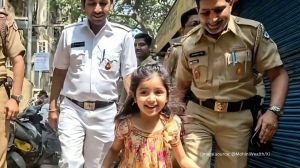The Twenty-five Kilometre Story: Let your child turn storyteller
Our twenty-five kilometre story transformed a tedious drive through Delhi traffic into a fun experience. It also helped me to discover how free ranging my grandson’s imagination was.
 Encourage your child’s creative efforts (Source: Getty Images)
Encourage your child’s creative efforts (Source: Getty Images)
Storytelling is a great way to bond with a child and it’s not necessary that the adult tell the story each time!
By Deepa Agarwal
What is a twenty-five-kilometre story? Simply put, a story that lasts for that length of a car ride.
I discovered the value of this kind of story recently while trying to keep my six-year-old grandson entertained during a long drive through the city. It was a story that he made up himself, with some encouraging questions from his older sister and Nani to keep the ball rolling.
Storytelling is one of the most enjoyable ways to cement bonds with a child, whether as a parent, grandparent or older relative. The sheer bliss of sharing your favourite tales or reading aloud from a picture book is unequalled. As you watch the child listening wide-eyed and engrossed, you slip into that fantasy world too, a world where everything is possible.
Stories provide entertainment for both teller and listener. They also expose children to a variety of experience, open up a world of ideas, increase their vocabulary and communicate values and life-skills. Kids learn to concentrate while following a narrative thread to its logical end, become better listeners too, something essential for assimilating knowledge in the classroom. By asking questions in between, they hone their comprehension and acquire the confidence to speak up when they need to clear their doubts in school.
But is it necessary that an adult always tell the story? While many children will beg you to retell an old favourite, there are others who are raring to reverse the process and tell you a story. Most likely, you will listen indulgently without considering the numerous benefits to be gained from it.
There are several aspects to a child’s storytelling. Firstly, it is the child’s inborn creativity coming to the fore, her imagination at work—stimulated by the stories you have told her. As we know, the world of fantasy is vibrantly alive in young children, that is why make-believe friends, monsters and other creatures are so real to them. Secondly, it’s a way of asserting themselves. Children get tired of being passive listeners all the time and want a chance to display their talents too!
At such a time, it’s very important to be a patient listener. Remember, your child is experimenting with new ideas. Her stories will ramble and lack the cohesive form of fiction written by an adult. There may not be the same logic that a conventional story possesses, but there will be much more for both of you.
And here are a few of the gains:
* Storytelling demonstrates that a child is so excited by stories that she wants to make up her own. This means she will be a good reader and perhaps a future writer.
* A story told by a child could contain a message she is trying to communicate, something she is inhibited about conveying in plain words.
* Telling a story to a sympathetic adult or two helps a child to develop confidence in public speaking and belief in her own ideas.
* No matter how wild and irrational the trajectory of the story, the fact that your child is interested in creating it, means that she is willing to experiment.
* As the story develops, if she gets stuck, you can propel it forward with cues, questions and pointers about characters, setting, time, like (if it’s a story about a cat) where the cat lived, what was her house like, what time did she leave her house, who did she meet, who helped her, who opposed her and so on. In this way your child can discover the basic elements of a story.
Respect your child’s story. Please listen with the same rapt attention she gives you. Laugh at comic situations, not because you feel the story is becoming too absurd. Do not destroy a child’s confidence by mocking her effort.
* You can carry this process further by suggesting that she draw the characters or events of the story in the form of a comic strip. I would advise minimum interference at this stage.
* You can also steer it into a cumulative story. This will provide an opportunity to repeat words and phrases to hone speaking skills, sentence construction and correct pronunciation. You can suggest animals new to her, people from different professions or different countries to acquire information in a fun way.
* If you wish to encourage a child who is hesitant about making up her own stories, visual creative sparks like pictures are invaluable.
* Listening to a story composed by a child is as entertaining an experience as telling her one. Apart from strengthening family bonds and fostering trust, it reveals the extent to which a child has absorbed the stories you have told her and how she has interpreted them.
* Our twenty-five kilometre story transformed a tedious drive through Delhi traffic into a fun experience. It also helped me to discover how free ranging my grandson’s imagination was, his ability to conjure up a variety of situations and bend the path of his story with magic spells a la Harry Potter. Now, I am a more eager listener than storyteller!
(Author, poet and translator, Deepa Agarwal writes for both children and adults and has over 50 books to her credit. She interacts regularly with children, conducting creative writing workshops and storytelling sessions in schools.)



- 01
- 02
- 03
- 04
- 05




























